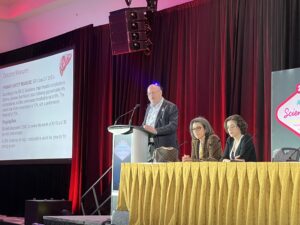
New data from a prospective, multicentre randomised controlled trial show similar hepatic progression-free survival (hPFS) using bland transarterial embolization (TAE) or transarterial chemoembolization (TACE) when treating neuroendocrine tumour metastases in the liver. Michael Soulen (University of Pennsylvania, Philadelphia, USA) presented these findings at the Society of Interventional Oncology (SIO) annual scientific meeting (30 January—3 February, Las Vegas, USA).
Soulen, for the first time, was presenting the results of the the Randomized Embolization Trial for NeuroEndocrine Tumor Metastases to the Liver (RETNET). He set out that TAE and TACE have been used to treat neuroendocrine liver tumours for over 50 years and are equally weighted in the National Comprehensive Cancer Network (NCCN) guidelines, due only to lack of controlled comparative data.
To gain better insight, RETNET was designed to analyse efficacy, toxicity and patient-reported outcomes for patients with liver-dominant neuroendocrine tumours randomised 1:1:1 to TAE with 40–500μm microspheres, TACE with lipiodol-docorubicin 40–500μm microspheres, and drug-eluting bead doxorubicin (DEBDOX) delivery. Patients received clinical, imaging and laboratory assessment, as well as patient-reported outcome assessments, every three months for two years following treatment.
Highlighting strict safety parameters in their study’s design, Soulen commented on “controversy” that had previously arisen during trials of DEBDOX which were halted early due to high complication rates. To acknowledge this, his team implemented a stopping rule which defined a 20% incidence of major complications to be grounds to close an arm.
Soulen and colleagues enlisted 14 sites in the USA, Canada, Argentina and Italy, with a total of 162 patients enrolled. He described that, during an early safety review while enrolling, they elected to close the DEBDOX arm due to a 40% treatment-related serious adverse event rate resulting in two intensive-care unit admissions, two permanent hepatobiliary injuries and two patients who could no longer participate in the trial.
“The good news is that we confirmed that DEBDOX is bad in neuroendocrine tumours,” Soulen told SIO attendees, a fact that has now been reflected in the NCCN guidelines. Going forward, their cohort was comprised of 78 patients randomised to TAE and 73 to TACE, with no significant baseline characteristic differences between groups, he stated.
Soulen reported that hPFS at two-year follow-up showed no difference (p=0.2) between TAE and TACE. Further, breaking hPFS down by grade, tumour burden, Eastern Cooperative Oncology Group (ECOG) performance status, and histology, Soulen and his team reported equivalent results between study arms.
His team analysed each arm by objective response rate (ORR), demonstrating TACE to have achieved a 40% ORR at three months which was sustained to two years, while TAE achieved a 60% ORR at three months, which “significantly declined” over two years to 20%, Soulen described.
Detailing unexpected insights from their data, Soulen stated that syndromic and female patients had better hPFS than non-syndromic patients or men. “This was very interesting and unexpected, and this is an outcome that still remains to be explored,” Soulen told delegates.
The speaker additionally reported a total of 101 severe adverse events in the TAE arm, versus 39 in the TACE arm—a large difference in event rate between groups which is awaiting detailed further analysis.
Summarising, Soulen stated TAE and TACE equally provided durable symptom control up to two years which was not influenced by tumour grade, burden or histology. Later, when asked where they go next by an audience member at his SIO 2025 talk, Soulen noted that further analysis of their data is set to be released in due course, focusing on overall survival and patient-reported outcomes.
“[These outcomes] are raising a lot of questions that were unexpected. I don’t know the answer, but we will need to pick apart these data in the context of these questions,” Soulen concluded.










